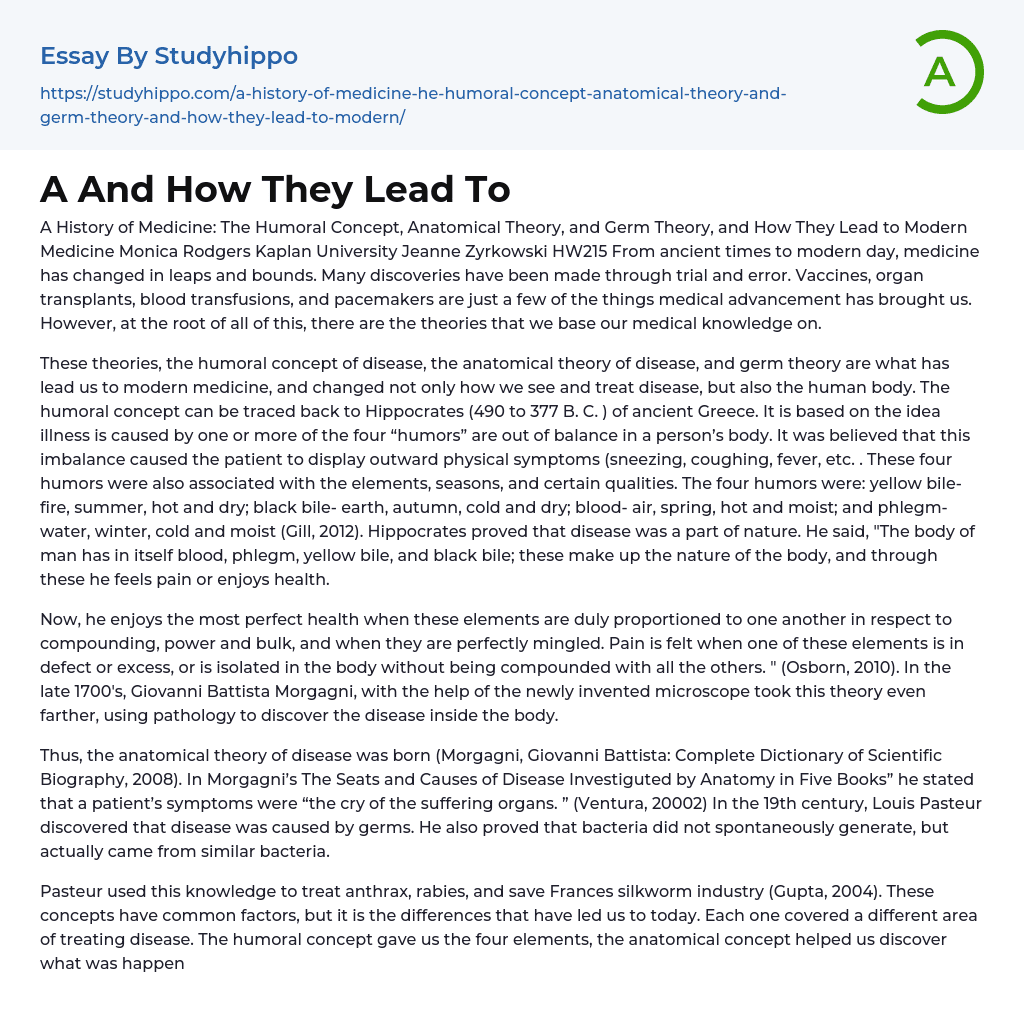Throughout history, medicine has undergone significant changes and achieved various experimental breakthroughs. Notable advancements include vaccines, organ transplants, blood transfusions, and pacemakers. However, these developments are rooted in fundamental theories that form the basis of our medical knowledge.
The humoral disease, anatomical disease, and germ theory concepts have greatly influenced modern medicine and our understanding of the human body. The idea of humoral disease can be traced back to Hippocrates (490 to 377 B.C.) in ancient Greece. According to this concept, imbalances in the four humors within a person's body were believed to cause illness. These imbalances manifested through physical symptoms like sneezing, coughing, and fever. Each humor was associated with specific elements, seasons, and qualities. For example, yellow bile was linked to fire, summer, hotness, and drynes
...s; black bile was tied to earth, autumn, coldness, and dryness; blood was connected to air, spring hotness,and moisture; while phlegm corresponded with water,winter,coldness,and moisture (Gill 2012). Hippocrates emphasized that disease is a natural part of life and stated "The body of man has in itself blood ,phlegm,yellow bile,and black bile: these make up the nature of the body,and through these he feels pain or enjoys health."
Now, when these elements are properly proportioned and perfectly mingled, he enjoys the most perfect health. However, if one of these elements is deficient or excessive, or if it is isolated in the body without being combined with all the others, pain is felt. Giovanni Battista Morgagni extended this theory even further in the late 1700s by utilizing pathology and the newly invented microscope to uncover diseases within the body. " (Osborn, 2010).
Thus, the anatomical
theory of disease was born (Morgagni, Giovanni Battista: Complete Dictionary of Scientific Biography, 2008). In Morgagni's The Seats and Causes of Disease Investiguted by Anatomy in Five Books" he stated that a patient's symptoms were "the cry of the suffering organs." (Ventura, 20002) In the 19th century, Louis Pasteur discovered that disease was caused by germs. He also proved that bacteria did not spontaneously generate, but actually came from similar bacteria.
Applying his knowledge, Pasteur utilized these principles to cure anthrax and rabies and also revive France's silkworm industry (Gupta, 2004). Although these ideas share similarities, it is their distinctions that have propelled us ahead. Each idea concentrated on a specific aspect of disease treatment. The humoral concept introduced the four elements, whereas the anatomical concept aided in comprehending internal bodily processes. However, the fusion of these two ideas ultimately resulted in germ theory, which subsequently led to the development of vaccines, antiseptics, and various cancer treatments.
The various key concepts have played a significant role in shaping the development of modern medicine. The humoral concept emphasized that external symptoms indicated internal issues within the body. On the other hand, anatomical theory aimed to identify the specific disease responsible for the observed symptoms. Germ theory, however, revealed the fundamental cause of the disease itself. Ultimately, these theories have collectively influenced and shaped medicine as it is currently understood. Despite their differences in findings and beliefs, these theories are interconnected, and without one theory, the discovery of others would not have been possible.
- Pregnancy essays
- Death essays
- Asthma essays
- Chronic Pain essays
- Diabetes essays
- Infection essays
- Infertility essays
- Pain essays
- Sexually Transmitted Disease essays
- Cholesterol essays
- Epidemic essays
- Pathogen essays
- Symptom essays
- Water supply essays
- Myocardial Infarction essays
- Chronic essays
- Hypertension essays
- Black Death essays
- Breast Cancer essays
- Down Syndrome essays
- Apoptosis essays
- Tuskegee Syphilis Experiment essays
- Type 2 Diabetes essays
- Hospital essays
- Physician essays
- Health Care Provider essays
- Universal Health Care essays
- Readmission essays
- Cloning essays
- Medical Ethics essays
- Patient essays
- Therapy essays
- drugs essays
- Cannabis essays
- Aspirin essays
- Cardiology essays
- Hemoglobin essays
- Pharmacology essays
- Surgery essays
- alternative medicine essays
- Plastic Surgery essays
- Organ Donation essays
- Vaccines essays
- Medical essays
- Dentist essays
- Psychological Trauma essays
- Physical therapy essays
- Cold essays
- Cocaine essays
- Why Marijuana Should Be Legalized essays




